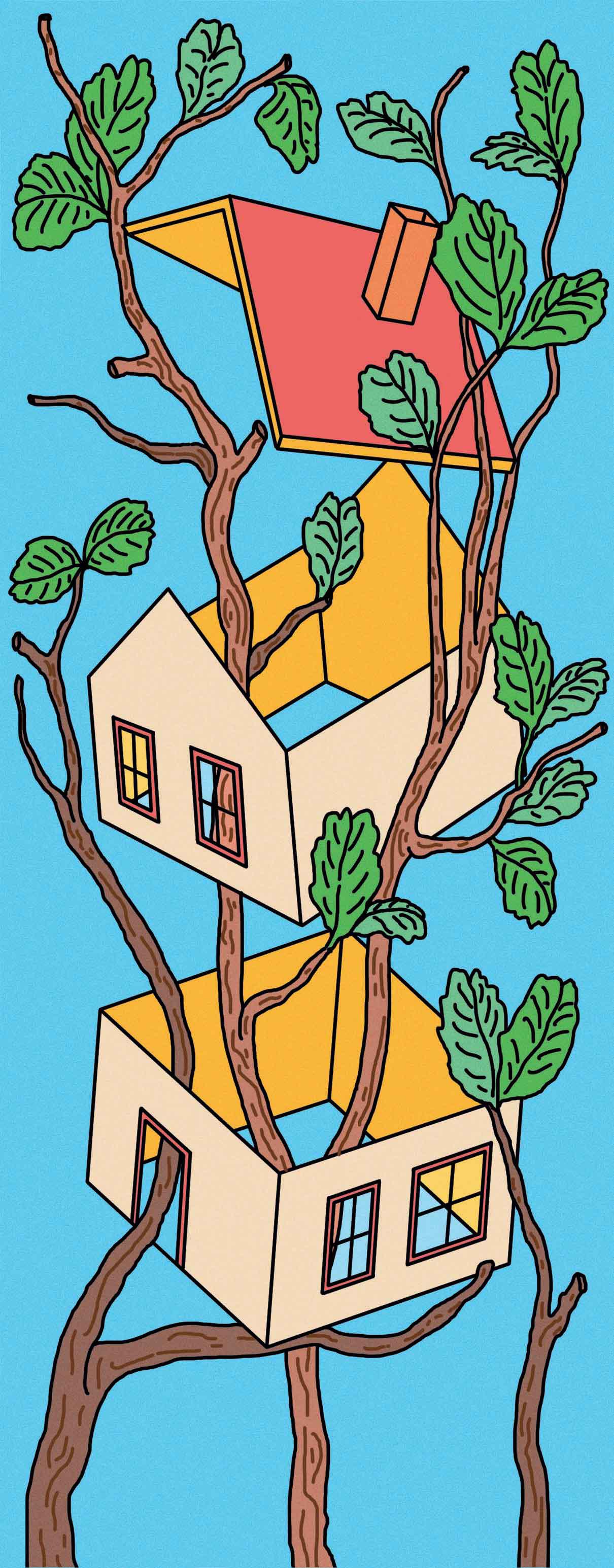
Sophie Delhay, an architect and EPFL professor, is promoting an entirely new approach to designing and building homes - 2024 EPFL/Jeanne Guerard - CC-BY-SA 4.0
Sophie Delhay, an architect and EPFL professor, is promoting an entirely new approach to designing and building homes. She believes we urgently need to break away from standard housing types that no longer correspond to today's reality or modern-day imperatives.
A new generation of architects is upending conventional construction practices in response to the societal shifts and challenges of the 21st century. Sophie Delhay is one of these architects. Based in France, she's an associate professor at EPFL, where she has taught for the past two years, and a specialist in residential architecture. She just took over as head of the School's architecture department. She spoke with us about her view of the future of housing as we celebrate World Habitat Day on 7 October.
What do you think are today's biggest housing challenges?
Housing is the backbone of city life, accounting for 80% of urban buildings and contributing directly to the quality of residents' experience. It can be a powerful vector for shaping people's aspirations, perspectives and lifestyles - both now and in the future. That's why I believe it's so important.
One of the biggest challenges we currently face is breaking free from established norms. The building methods employed over the past two decades have been heavily shaped by capitalist objectives, with a number of housing models becoming set in stone. Industry standards were adopted with the goal of cutting costs and improving the speed and efficiency of the design process. Often, these standards were driven by commendable aims: to make housing affordable for everyone, ensure disabled access, reduce the risk of fire, and so on.
But all this removed a lot of flexibility in how homes are built, and now we need to put that flexibility back. Recent environmental, demographic and societal shifts mean we have no choice but to change how we live and produce. Current norms are outdated and based on sociological patterns from the 1970s that no longer exist.
However, these challenges also bring an amazing opportunity. We can now reinvent the very concept of housing, imagine new designs and explore a world of possibilities. Yet beyond innovating and experimenting, what we really need is to make better use of our existing housing stock.
What's changed in the past 50 years?
First of all, the "typical household" - a couple with one or two children - has changed. Yet many residential properties are still built according to this archetype. Family units aren't as stable as they used to be, and their size often fluctuates as people move in and out as they go through life. There are also more blended families in which children sometimes have two bedrooms in two separate homes - even though we need to build less housing overall.
In addition, the aging population means we need enough housing for not three, but four or even five generations. Many elderly people live on their own for as long as possible. Some have taken inspiration from college students and live in flatshares with other senior citizens or younger people. This echoes the large intergenerational households of the past. And then there are people who split their time between two or more residences.
Our relationship with the domestic space changed following the lockdowns. Many activities that we used to do externally - watching a movie, dining at a restaurant, taking a class and working - are now done at home.
How can we best respond to these shifts?
We need to account for this new reality - but without building more housing. This will require inventing alternatives. To that end, I'm a big believer in co-living arrangements and undefined spaces, or spaces whose function can change from one day, week, year or even generation to the next.
Residents must be able to make their homes their own and decide how to live in them - that's the essential quality of a home. Due to the shifts mentioned earlier, as architects we no longer know whom we're designing for: what kind of family, how big it is, etc. Homes must therefore be designed to accommodate as many different configurations, and provide for as much freedom, as possible. I see my job as similar to that of a composer. I write the score, and the residents, as musicians, interpret the music in their own way.

What do you mean by co-living?
The breakdown of the archetypical family unit has opened the door to new ways of living together. It's human nature to seek shelter in times of difficulty - to build walls and create distance. But at the same time, we need social relationships. Architects have a role to play in enabling social connections and civic awareness.
For example, in my master's studio, I asked students to design a large residence for around 100 people, but with a smaller surface area than would be used for that number of people under current standards. The students were free to determine the size of the individual living spaces - that is the surface area available for each person or family unit - and the size of the common areas. The common areas had to be of excellent quality in terms of giving residents something they wouldn't be able to find (or would be hard to find) if they lived independently. The idea was to show that people can live better together than separately, in arrangements which every person finds beneficial and finds joy in sharing.
The pressing challenges at the start of this century spurred the rapid construction of new homes on a massive scale, creating very dense urban spaces. Many people struggle with this dense living environment, but today we basically have no choice. What we can do, however, is restructure and give a new form to highly populated spaces.
So it's our perceptions and mental constructs that need to be reshaped?
That really is essential. At EPFL, that's what we're doing with our students, since their minds haven't yet been imprinted with conventional practices. For instance, we're carrying out interesting and unique research on kitchens. Architects in past decades have largely underestimated the role and importance of these spaces. Kitchens have untapped potential not only for consolidating social ties and forming bonds - they're also traditionally considered a woman's domain - but also for helping to improve a home's energy efficiency. And as kitchens brings together the four elements of air, water, earth and fire, they can also be central to environmental efforts. By approaching kitchens from these two angles - social ties and environmental benefits - we can unlock new ways of thinking about them.
What role can building materials play in all this?
The choice of which building materials to use will stem naturally from the new construction methods and approaches we're exploring, and will form part of a holistic, balanced approach. For instance, the construction industry must imperatively use less concrete - a material that's ubiquitous in conventional practices - and viable alternatives do exist. Counterintuitively, however, concrete can sometimes be an environmentally friendly choice. If used wisely, concrete can lighten certain structures and enable architects to build spaces that wouldn't be possible otherwise.
Biosourced materials such as wood, raw earth, straw and hemp will play a fundamental role in modern buildings. They'll enable us to meet the need for thicker walls and more thermal insulation, for example.
What about spaces for vegetation?
I think gardens are vital, as if every garden can be considered a Garden of Eden. Today, it's more important than ever to preserve fertile tracts of land in order to keep soil alive, create "cool islands" in urban areas and cut carbon emissions. Here too, the lockdowns showed us just how important it is to stay connected with plants and nature. Gardens are central to most people's conception of a house, but the typical "dream home" - a detached house with a garden - is no longer sustainable on a large scale. However, we can give everyone access to green spaces and design them in ways that reflect and sustain this aspiration. Gardens should be an integral component of all collective housing - spaces where residents can connect with nature while feeling they've got a place of their own.
How can we convince the industry of the merits of this new approach?
Architects and urban planners need to roll up their sleeves. Recent parliamentary elections in France showed a clear divide between voters living in rural vs. urban areas. Regional and local challenges need to be addressed, and that's something that directly affects architects and others in the construction industry. Housing makes up 80% of cities but 100% of society. It's an issue that concerns everyone. New housing approaches can be an effective way to restore residents' trust, whether in terms of opening up to others, sharing or building solidarity. These values are supported through architecture. And not just through the buildings we construct - even our designs can unleash new ways of thinking. We can demonstrate that there are excellent reasons to live together in society, and that it can be both useful and enjoyable.







